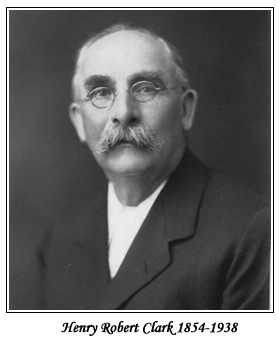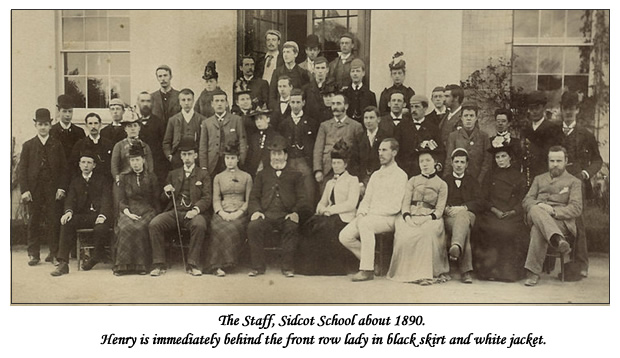Henry Robert Clark was my great grandfather and was born in 1854 in Bristol. I have always been unsure as to how Henry started down the path to becoming a schoolmaster; his father was a factory worker and all his grandparents, and those before them, had been agricultural labourers.

At the age of twelve, by which time many of his contemporaries had finished their education, Henry became a boarder at Sidcot School, a Quaker establishment at Sidcot in North Somerset. Whilst Sidcot was originally set up ‘for the benefit of the children of Friends in low circumstances’, his parents were not Quakers and they wouldn’t have had sufficient funds to send their child into ‘further education’, so the cause of this good luck remains a mystery. None of his siblings seem to have had this privilege.
Henry remained at Sidcot until he was fifteen, at which time he was sent, as an apprentice schoolmaster, to the Quaker Wigton School in Cumberland, and remained there until he was twenty-two, during which time he also had training at another Quaker establishment, The Flounders Institute at Ackworth in Yorkshire.
He first taught as a fully-fledged master at Headingley Hill School in Leeds and a short stay there was followed by two years at Newtown in County Waterford. After this, however, Henry returned to his roots as, late in 1881, he took up a post at Sidcot School where he had been a student some twelve years earlier and where he would remain for the next thirty-nine years.
At this point Henry was still not a convert to Quakerism, but this was not to be the case for long, as he very soon met his wife to be. Mary Louisa Buck had been a student at Sidcot from 1872 until 1876 and after this had remained as a governess to the young children of the headmaster. She was descended from generations of Quakers, and not long before their marriage in 1884, Henry became a member of the Society of Friends (otherwise known as the Quakers).
At Sidcot Henry was employed as an Art Master, but also taught mathematics to the lower school. Though strict, he was very kindly towards his students and forever patient with those who found mathematics unintelligible! He was of a humorous disposition and happily accepted his nicknames of ‘Doodles’, because he liked drawing, and ‘Barn Owl’, because of his habit of looking over the top of his glasses at his students. He would also spot disorder in class by looking at the reflection in his spectacles which greatly surprised some of the younger children!
Victorian Quaker schools were considered fairly progressive. Girls and boys received the same education, except for needlework and woodwork, which divided the sexes. Classes were also mixed by the late Victorian period and at Sidcot the normal leaving age for all students was eighteen by the time Henry was teaching there.
Henry’s wife was also involved in school life as she cared for any students convalescing from illness, at their home. Sometimes these children were not in recovery and two or three died whilst in her care which troubled her greatly, mainly because they were not at home with their families.
Henry had a great interest in music, particularly singing and he was a member of the Winscombe Choral Society for many years. The society occasionally gave recitals and Henry was in trouble from time to time for including items not considered suitable for female ears. One song was called ‘You Dirty Little Scrub’!!

All Henry’s children attended Sidcot School. In 1914, when war broke out, Henry had been considering retirement, but as several of the younger teachers were joining the services, he was persuaded to stay on. He then found himself in the slightly awkward predicament of being a Quaker and a pacifist teaching in a Quaker school, but having two sons in the army. I was interested to see that he signed a form to allow his younger son to join up, despite his own beliefs. Unfortunately the same son didn’t return from the war.
As well as singing Henry also enjoyed gardening, spending more time cultivating after he retired in 1920, following the return of some teaching staff from the war. He would spend hours in the greenhouse, wearing a striped blue butcher’s apron and with a small knife held between his teeth, trimming plants and transplanting seedlings. He believed gardening to be a very apt occupation for a schoolmaster, “We sow and watch with patience; we must look ahead and be prepared for the future and must learn it’s not always the most promising seedling that develops into the most promising plant”.
He was not above being taught by others either. An old countryman watched Henry carefully pruning a rambling rose. When Henry had finished, the old man said, “Let I have them shears a minute, sir”, and he cut away until there was scarcely anything left. He then handed Henry the shears, looked with pride at his handiwork and said, “Thur, now let un enjoy ‘isself”, and the rose flourished like never before.

After his retirement Henry took on the job of collecting the rates in Winscombe, where he had lived from about 1902. Unfortunately, he found it necessary to summon half the village for non-payment. The last man on the job had been afraid to be tough as he was also the milkman and was worried about losing business. The rates money that was collected was hidden in the house in a commode with a pair of Henry’s trousers carefully draped across, until it could be taken to the bank!
Henry was quite conservative in his dress, though from his 40’s onwards he always wore a white piquet tie. He also never wore shoes, always preferring boots.
In 1928, Henry’s wife died and he moved away from Somerset to live with his sister who had been a matron at another Quaker school, Leighton Park, at Reading St Giles in Berkshire. She lived in the school grounds as she was lucky enough to have had a house built for her there by a grateful ex-pupil, who she had looked after in his youth.
In 1935, at the age of 80, Henry remarried to a much younger bride, who he had met whilst on holiday in the Mediterranean the previous year. They lived together at Welwyn Garden City in Hertfordshire until Henry’s death in 1938. Henry’s body was returned to his beloved Sidcot and he was buried in the Quaker burial ground within the grounds of the School, alongside his first wife, Mary.
Merry Monty Montgomery
© Merry Monty Montgomery 2008
SOURCES
Sidcot School archives
Ackworth School archives
Census records
Civil registration records
Memoirs of Henry’s younger daughter
WW1 army service records
Family photographs